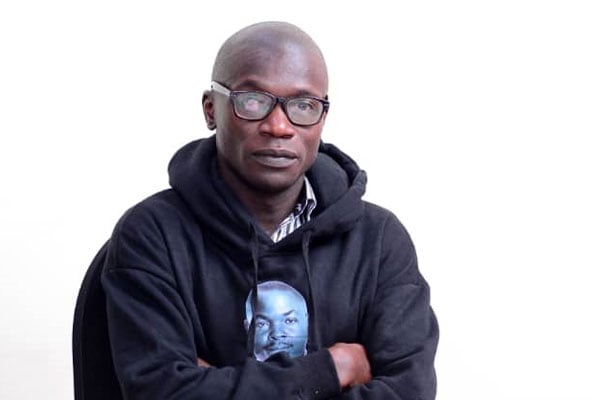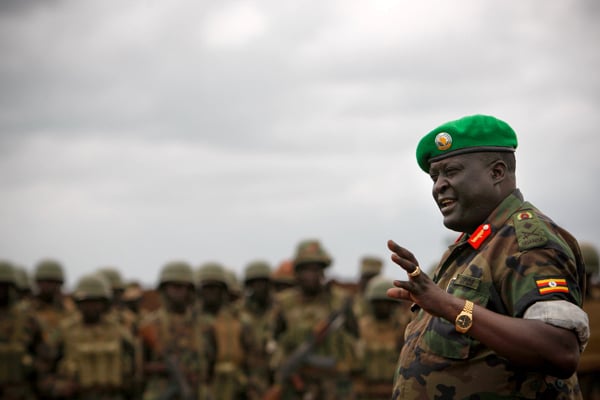Prime
Is pacifying Somalia Africa’s forever war?

UPDF soldiers in Lower Shabelle region of Somalia ian 2017. Uganda was first to send forces into Somalia under Amisom, and has maintained the largest contingent in the country. PHOTO/ATMIS
What you need to know:
- The fight against Islamic militants in Somalia is a part of America’s global war on terror, but with al-Shabaab militants being able to carry out audacious attacks from time to time, Uganda could be trapped in a forever war in the Horn of Africa, Derrick Kiyonga writes.
In April, there was an extraordinary summit in Uganda’s lakeside town of Entebbe for leaders of countries contributing troops to fight al-Shabaab Islamist militants in Somalia under the umbrella of the African Union Transition Mission in Somalia (ATMIS).
The summit was attended by Hassan Sheikh Mohamud (Somalia), Ismail Omar Guelleh (Djibouti), Evariste Ndahishimiye (Burundi), William Ruto (Kenya) Demeke Mekonnen (Ethiopia’s deputy prime minister) and Uganda’s Museveni, their host who declared that Africa can solve its problems.
“So, this problem, the one we have discussed today, I’m sure we can solve,” Museveni said, reminding colleagues of how Tanzania sorted out Uganda’s Idi Amin in the 1970s and how East African countries solved the political crisis in Burundi.
ATMIS’ mandate ends in 2024. The summit shared views on how Somalia’s government would take over. It wasn’t the first time African leaders were talking about leaving the Somali government to take responsibility for the war-torn country. Before ATMIS emerged in 2022, foreign troops in Somalia were operating under the auspices of the African Union Mission in Somalia (Amisom).
Amisom’s mandate started in 2007, with African leaders envisioning that they would degrade al-Shabaab and build the capacity of the Somali security forces, so that the mission could eventually withdraw in 2021.
The withdrawal didn’t happen as the threat posed by al-Shabaab required continued presence of Amisom. The idea of Somalian forces taking charge of the country has again been questioned following the May 26 al-Shabaab raid on an ATMIS Forward Operating Base (FOB) occupied by Ugandan troops in Bulo Marer, 130 kilometres southwest of the Somali capital, Mogadishu. President Museveni revealed that 54 soldiers were killed in the raid.
“If UPDF that’s meant to train Somali security forces can’t see a group of over 800 militants coming closer to its base, then how will the Somali military fight them on their own?” Kira Municipality MP Ibrahim Ssemujju Nganda asks.
Somalia has for more than four decades been troubled by armed conflict waged by different groups. Although Somalia is culturally, religiously, and linguistically homogenous, the country’s population is divided into clans. During the colonial period under Italy and Great Britain, clans became a central feature of state administration and political competition.
Colonial administrators established a patrimonial system of resource distribution and employed tactics of divide and rule along clan lines.
The fall of Siad Barre, who had ruled Somalia between 1969 and 1991, triggered a period of lawlessness. The Islamic Courts Union (ICU) organisation emerged to fill the vacuum. In the absence of state authority, Jon Abbink, a researcher on politics and governance in Africa, says ICU responded to the social needs of local people and grew into a large militia force.
By late 2006, it controlled much of southern Somalia.
In the early 2000s, an extremist group formed within ICU and served as its youth militia (al-Shabaab). The al-Shabaab and ICU took control of Mogadishu in June 2006, a victory that stoked fears in neighbouring Ethiopia of spill-over Muslim jihadi violence.
In 2001, the American government administration of George Bush, French sociologist Roland Marchal says, debated for weeks whether to enter Somalia, which was described as a potential al-Qaeda terrorist base. This was post-9/11 and the Americans were looking for a proxy force to carry on its global war on terror in the Horn of Africa theatre.
With the backing of America in 2006, Ethiopia, an orthodox Christian majority nation, invaded Somalia in December 2006 and kicked the ICU out of Mogadishu.
That intervention, which came at the reported request of Somalia’s weak and exiled transitional government, radicalised al-Shabaab, experts say.
ALSO READ: Uganda army moves to pick up the pieces
After much of the ICU fled to next-door countries, al-Shabaab retreated to the south, where it began organising guerrilla attacks on Ethiopian forces.
When the ICU were ousted, the East African regional body, Inter-Government Authority on Development (Igad) put in place a Peace Support Mission to Somalia (IGASOM) – effectively a peacekeeping mission on behalf of the African Union (AU).
But the idea of bringing forces from outside to flash out militants has been criticised as unsustainable.
In March 2006, Terry Mays, a political scientist, wrote that Kenya’s Foreign ministry declared that despite its best efforts, Igad had failed in its attempts to deploy a peacekeeping mission to Somalia.
The minister gave three reasons: a fragmented political approach; the lack of funding; and the existence of a UN arms embargo on Somalia.
The AU, like the Organisation of African Union (OAU) before it, May said, was cash-strapped.
“Large-scale projects, including peacekeeping, are beyond their limited capability. For example, the AU Peace and Security Council budget for 2005 was $158m (Shs583b), while the AU’s cost for its peacekeeping mission in Sudan during the same period was $222m (Shs820b). Igad estimated the operations in Somalia would cost approximately $413m (Shs1.5 trillion) annually,” May said.
May noted that the AU, and OAU, relied on external funding for its peacekeeping operations. While African states are quick to pledge money for AU programmes, few follow through with the cash. May says Igad grappled with this problem throughout 2006 until the AU assumed direct responsibility, leading to Amisom’s entry in January 2007.
Uganda was first to send forces into Somalia under Amisom, and has maintained the largest contingent. Then in mid-2010, al-Shabaab, which is listed by the US State Department as a terrorist organisation, declared allegiance to al- Qaeda in 2012. By then, it controlled vast swathes of central and southern Somalia. According to various experts, al-Shabaab has built up a large war chest, drawing revenues from checkpoint tolls; taxes on imported goods; zakat, an annual religious tax; piracy; kidnapping, and extortion.
In 2012, Burundian and Ugandan Amisom contingents were joined by Kenyan and Ethiopian forces. Together, they pushed al-Shabaab out of major towns in central and southern Somalia. But the militants still kept up spontaneous attacks on Amisom, sometimes with devastating effect.
In January 2016, they attacked a Kenyan army camp in El Adde, killing 200 soldiers. Before the Bulo Marer attack, Uganda’s biggest losses were in 2019 when a base in Janaale was overrun, leaving 19 soldiers dead.
Monitor reported a year later that the tragedy in Janaale was made possible because soldiers at the base were short of equipment, and that there were operational blunders. The story revealed that for support weapons, the detachment had one 14.5mm and one 12.7 mm anti-aircraft gun, one 83mm and 60mm mortar and a handful of general purpose machine guns.
In the May 26 debacle, an angry President Museveni has said the Ugandan army unit in Bulo Marer was not combat-ready, and was populated by unprepared troops. He blamed corruption in the UPDF for the deployment of ill-prepared troops, including cooks, personal assistants and bodyguards in Somalia – because of the temptation of better pay.
“Those defences are quite strong, although they are guarded by light weapons. There were two tanks, two 14.5mm anti-aircraft guns, and a 107mm Katyusha rocket launcher. Some of these soldiers there did not perform as expected and panicked, which disorganised them and the al-Shabaab took advantage of that to overrun the base and destroy some of the equipment,” Mr Museveni said.
The President said the Bulo Marer attack should remind everyone that combat missions are not welfare missions where you can access UN allowances.
“It is criminal for anybody involved to send into such a theatre a soldier who is either not suited for that mission or not properly prepared for it,” he said.
Two army majors; Oluka and Obbo, have been arrested and await court martial for reportedly ordering soldiers to run away in the heat of the battle on May 26.
With al-Shabaab still showing such potency, there is a fear that regional forces may be forced to extend their presence in Somalia beyond December 2024, mainly in order to midwife dialogue between the Somali clans.
Clearly, based on Somalia’s history of protracted conflict, and the evidence of al- Shabaab’s willingness to fight an unending guerilla war of attrition, military force on its own may not provide the long-term answer to the many political questions in this troubled land.
Al-Shabaab attacks outside Somalia
Al-Shabaab attacks haven’t been restricted to Somalia. In 2010, they claimed responsibility for the twin suicide bombings that killed 74 people in Kampala on the day of the football World Cup finals.
“We are sending a message to every country willing to send troops to Somalia that they will face attacks on their territory,” al-Shabaab said in a statement at the time.
Two years later in 2013, al-Shabaab also claimed responsibility for the equally daring attack on a Nairobi, Kenya, shopping mall that killed 67 people, and in 2015, the group killed 148 civilians in an attack on a university campus in Garissa.
The Garissa incident was the deadliest terror attack in Kenya since the 1998 bombing of the US embassy in Nairobi by al-Qaeda in which more than 200 people died.





